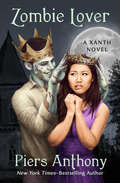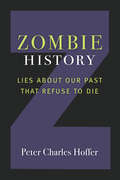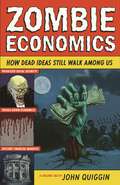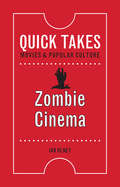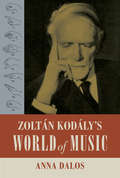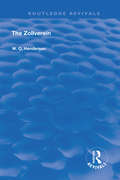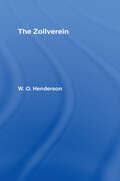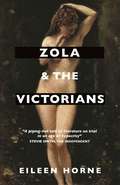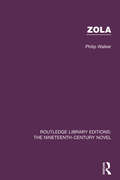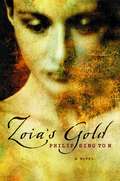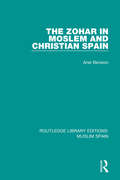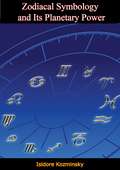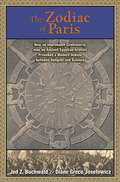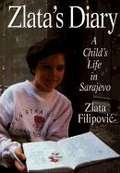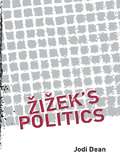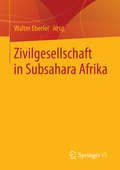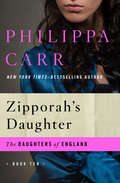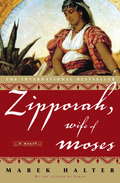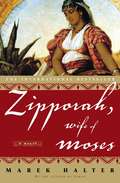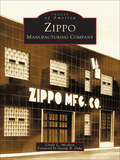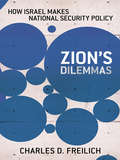- Table View
- List View
Zombie Lover (Xanth #22)
by Piers AnthonyFleeing Xeth's unwanted advances, Breanna uses all of her worldly wiles to escape a fate that is literally worse that death. With the help of some colorful companions, including King Dor, Prince Dolph, and a "youthened" Magician Bink- and Justin Tree, who serves as her spirit guide on this oddest of odysseys- Breanna sets out on a perilous quest. Her travels lead from the Region of Madness to the evanescent Isle of Women, which is ruled by women, and on to Xanth's myriad "worlds of maybe" orbiting Queen Ida's head. And at the end of her unearthly journey she discovers a surprising fulfillment of her fondest desires.
Zombie Lover (The Xanth Novels #22)
by Piers AnthonySomething&’s rotten in the land of Xanth—and it&’s not just the undead—in this &“cheeky&” adventure in the New York Times–bestselling series (Publishers Weekly). Horrors and hilarity collide as a fate far worse than death awaits a vivacious young visitor to &“the Florida-shaped fantasy land where anything goes and the puns pack every page&” (Kirkus Reviews). Breanna, a beautiful young newcomer to the enchanted land of Xanth, must deal with a distressing dilemma. She has unwittingly attracted the affections of King Xeth, ruler of Xanth&’s Zombies, who yearns to make her queen of the undead! Her quest to preserve her innocence, and find her destiny, takes her on an exhilarating excursion packed with perils, puzzles, and piles of puns. Zombie Lover will provide a profusion of macabre merriment.
Zombie History: Lies About Our Past that Refuse to Die
by Peter Charles HofferFake history is not a harmless mistake of fact or interpretation. It is a mistake that conceals prejudice; a mistake that discriminates against certain kinds of people; a mistake held despite a preponderance of evidence; a mistake that harms us. Fake history is like the Zombies we see in mass media, for the fake fact, like the fictional Zombie, lives by turning real events and people into monstrous perversions of fact and interpretation. Its pervasiveness reveals that prejudice remains its chief appeal to those who believe it. Its effect is insidious, because we cannot or will not destroy those mischievous lies. Zombie history is almost impossible to kill. Some Zombie history was and is political, a genre of what Hannah Arendt called “organizational lying” about the past. Its makers designed the Zombie to create a basis in the false past for particular discriminatory policies. Other history Zombies are cultural. They encapsulate and empower prejudice and stereotyping. Still other popular history Zombies do not look disfigured, but like Zombies walk among us without our realizing how devastating their impact can be. Zombie History argues that, whatever their purpose, whatever the venue in which they appear, history Zombies undermine the very foundations of disinterested study of the past.
Zombie Economics: How Dead Ideas Still Walk among Us
by John QuigginIn the graveyard of economic ideology, dead ideas still stalk the land. The recent financial crisis laid bare many of the assumptions behind market liberalism--the theory that market-based solutions are always best, regardless of the problem. For decades, their advocates dominated mainstream economics, and their influence created a system where an unthinking faith in markets led many to view speculative investments as fundamentally safe. The crisis seemed to have killed off these ideas, but they still live on in the minds of many--members of the public, commentators, politicians, economists, and even those charged with cleaning up the mess. In Zombie Economics, John Quiggin explains how these dead ideas still walk among us--and why we must find a way to kill them once and for all if we are to avoid an even bigger financial crisis in the future. Zombie Economics takes the reader through the origins, consequences, and implosion of a system of ideas whose time has come and gone. These beliefs--that deregulation had conquered the financial cycle, that markets were always the best judge of value, that policies designed to benefit the rich made everyone better off--brought us to the brink of disaster once before, and their persistent hold on many threatens to do so again. Because these ideas will never die unless there is an alternative, Zombie Economics also looks ahead at what could replace market liberalism, arguing that a simple return to traditional Keynesian economics and the politics of the welfare state will not be enough--either to kill dead ideas, or prevent future crises. In a new chapter, Quiggin brings the book up to date with a discussion of the re-emergence of pre-Keynesian ideas about austerity and balanced budgets as a response to recession.
Zombie Cinema
by Ian OlneyIt’s official: the zombie apocalypse is here. The living dead have been lurking in popular culture since the 1930s, but they have never been as ubiquitous or as widely-embraced as they are today.Zombie Cinema is a lively and accessible introduction to this massively popular genre. Presenting a historical overview of zombie appearances in cinema and on television, Ian Olney also considers why, more than any other horror movie monster, zombies have captured the imagination of twenty-first-century audiences. Surveying the landmarks of zombie film and TV, from White Zombie to The Walking Dead, the book also offers unique insight into why zombies have gone global, spreading well beyond the borders of American and European cinema to turn up in films from countries as far-flung as Cuba, India, Japan, New Zealand, and Nigeria. Both fun and thought-provoking, Zombie Cinema will give readers a new perspective on our ravenous hunger for the living dead.
Zoltan Kodaly's World of Music (California Studies in 20th-Century Music #27)
by Anna DalosHungarian composer and musician Zoltán Kodály (1882–1967) is best known for his pedagogical system, the Kodály Method, which has been influential in the development of music education around the world. Author Anna Dalos considers, for the first time in publication, Kodály’s career beyond the classroom and provides a comprehensive assessment of his works as a composer. A noted collector of Hungarian folk music, Kodály adapted the traditional heritage musics in his own compositions, greatly influencing the work of his contemporary, Béla Bartók. Highlighting Kodály’s major music experiences, Dalos shows how his musical works were also inspired by Brahms, Wagner, Debussy, Palestrina, and Bach. Set against the backdrop of various oppressive regimes of twentieth-century Europe, this study of Kodály’s career also explores decisive, extramusical impulses, such as his bitter experiences of World War I, Kodály’s reception of classical antiquity, and his interpretation of the male and female roles in his music. Written by the leading Kodály expert, this impressive work of historical and musical insight provides a timely and much-needed English-language treatment of the twentieth-century composer.
The Zollverein: The Zollverein (Routledge Revivals)
by William Otto HendersonPublished in 1959: This book is the only detailed study of the origin of the German customs union and its history up to the establishment of the united Reich in 1871. It is based on the author's researches in the Public Record Office and in the archives as Berlin and Vienna and takes full account of the numerous monographs by German Scholars on various aspects of Zollverein history.
Zola and the Victorians: Censorship in the Age of Hypocrisy
by Eileen HorneLondon, 1888: Jack the Ripper stalks the streets of Whitechapel; national strikes and social unrest threaten the status quo; a grave economic crisis is spreading across the Atlantic . . . Yet Her Majesty's government is preoccupied with "a mere book" - or rather, a series of books: new translations of the Rougon-Macquart saga by French literary giant Émile Zola.In his time, Zola made his British contemporaries look positively pastoral; much of his work is considered shocking and transgressive even now. But it was his English publisher who bore the brunt of the Victorians' moral outrage at Zola's "realistic" depictions of striking miners, society courtesans and priapic, feuding farmers.Seventy years before Lady Chatterley's Lover broke the back of British censorship, Henry Vizetelly's commitment to publishing Zola, and to the nascent principle of free speech, not only landed him in the dock and thereafter in prison, but brought to ruin to the publishing house he had founded. Meanwhile, Zola was going from strength to strength, establishing his reputation as a literary legend and falling in love with a woman half his age.This lively, humorous and ultimately tragic tale is an exploration of the consequences of translation and censorship which remains relevant today for readers, publishers and authors everywhere.
Zola and the Victorians: Censorship in the Age of Hypocrisy
by Eileen HorneLondon, 1888: Jack the Ripper stalks the streets of Whitechapel; national strikes and social unrest threaten the status quo; a grave economic crisis is spreading across the Atlantic . . . Yet Her Majesty's government is preoccupied with "a mere book" - or rather, a series of books: new translations of the Rougon-Macquart saga by French literary giant Émile Zola.In his time, Zola made his British contemporaries look positively pastoral; much of his work is considered shocking and transgressive even now. But it was his English publisher who bore the brunt of the Victorians' moral outrage at Zola's "realistic" depictions of striking miners, society courtesans and priapic, feuding farmers.Seventy years before Lady Chatterley's Lover broke the back of British censorship, Henry Vizetelly's commitment to publishing Zola, and to the nascent principle of free speech, not only landed him in the dock and thereafter in prison, but brought to ruin to the publishing house he had founded. Meanwhile, Zola was going from strength to strength, establishing his reputation as a literary legend and falling in love with a woman half his age.This lively, humorous and ultimately tragic tale is an exploration of the consequences of translation and censorship which remains relevant today for readers, publishers and authors everywhere.
Zola (Routledge Library Editions: The Nineteenth-Century Novel #38)
by Phillip WalkerIn the novels of Emile Zola, the pain and horror of working class life was pushed into the drawing rooms of polite society. Zola set out to shock and to question the assumptions of fiction and of comfortable, settled lives. The impact of his writing was far wider than France, and his attacks on the pillars of society gave him an international reputation. First published in 1985, this biography of Zola does much more than simply describe Zola as a writer, and his literary impact. It brings together the many strands of Zola’s life and creates an impression of a remarkable, if often exasperating individualist. This book will be of interest to those studying the works of Emile Zola and more broadly nineteenth-century and French literature.
Zoia's Gold
by Philip SingtonStockholm, December 1999. Madam Zoia, the enigmatic "painter on gold," is dead. The last surviving member of the Romanov court, she leaves behind a house full of paintings, a collection of private papers, and a mystery. Marcus Elliot travels to Sweden to write the catalog that will accompany the sale of her work. But something feels wrong. Behind the gilded serenity of Zoia's art lie the shadows of a secret life: a dramatic escape from the Bolshevik torturers of the Lubyanka prison, an artistic journey that embraced the excesses of Bohemian Paris, and an unearthly ability to command the devotion of desirable men. Marcus is to be Zoia's last, triumphant seduction, but with time against him, he must lay his own ghosts to rest -- the scandal that ruined him, the tragedy that shattered his childhood -- before the priceless truth can come within his grasp. In Zoia's Gold, Philip Sington seamlessly merges past and present, fact and fiction into a bewitching, compulsively readable novel of obsession, betrayal, and redemption.
Zoia's Gold
by Philip SingtonStockholm, December 1999. Madam Zoia, the enigmatic "painter on gold," is dead. The last surviving member of the Romanov court, she leaves behind a house full of paintings, a collection of private papers, and a mystery. Marcus Elliot travels to Sweden to write the catalog that will accompany the sale of her work. But something feels wrong. Behind the gilded serenity of Zoia's art lie the shadows of a secret life: a dramatic escape from the Bolshevik torturers of the Lubyanka prison, an artistic journey that embraced the excesses of Bohemian Paris, and an unearthly ability to command the devotion of desirable men. Marcus is to be Zoia's last, triumphant seduction, but with time against him, he must lay his own ghosts to rest -- the scandal that ruined him, the tragedy that shattered his childhood -- before the priceless truth can come within his grasp. In Zoia's Gold, Philip Sington seamlessly merges past and present, fact and fiction into a bewitching, compulsively readable novel of obsession, betrayal, and redemption.
The Zohar in Moslem and Christian Spain (Routledge Library Editions: Muslim Spain)
by Ariel Bension‘The Zohar’ was compiled and composed in Spain in the thirteenth century, and exerted a powerful influence on Jewish life in medieval ghettoes. In this book, first published in 1932, Dr Bension was the first scholar to deal with the influence on Jewish mysticism of certain characteristics which underlie so much of the literature produced in Spain both by Christians and Muslims.
Zodiacal Symbology and Its Planetary Power
by Isidore KozminskyAfter some years of careful study in the endeavour to fix the special planetary influence attached to each degree of the Zodiac, author Isidore Kozminsky is at length enabled to present the result of his researches in this direction for the consideration of the many sincere students who find in astrology a safe and sure foundation upon which to build the temple of world enlightenment, which the approaching true civilization will demand.From a close examination of thousands of nativities during the past, Kozminsky believes that the planets which will be found associated with the zodiacal degrees in this book are correct and important in every particular. He further believes this is the first attempt in this direction, and is certain that the reader will find it helpful in dealing with the many problems with which he or she has to grapple.
The Zodiac of Paris: How an Improbable Controversy over an Ancient Egyptian Artifact Provoked a Modern Debate between Religion and Science
by Jed Z. Buchwald Diane Greco JosefowiczThe clash of faith and science in Napoleonic FranceThe Dendera zodiac—an ancient bas-relief temple ceiling adorned with mysterious symbols of the stars and planets—was first discovered by the French during Napoleon's campaign in Egypt, and quickly provoked a controversy between scientists and theologians. Brought to Paris in 1821 and ultimately installed in the Louvre, where it can still be seen today, the zodiac appeared to depict the nighttime sky from a time predating the Biblical creation, and therefore cast doubt on religious truth. The Zodiac of Paris tells the story of this incredible archeological find and its unlikely role in the fierce disputes over science and faith in Napoleonic and Restoration France.The book unfolds against the turbulence of the French Revolution, Napoleon's breathtaking rise and fall, and the restoration of the Bourbons to the throne. Drawing on newspapers, journals, diaries, pamphlets, and other documentary evidence, Jed Buchwald and Diane Greco Josefowicz show how scientists and intellectuals seized upon the zodiac to discredit Christianity, and how this drew furious responses from conservatives and sparked debates about the merits of scientific calculation as a source of knowledge about the past. The ideological battles would rage until the thoroughly antireligious Jean-François Champollion unlocked the secrets of Egyptian hieroglyphs—and of the zodiac itself. Champollion would prove the religious reactionaries right, but for all the wrong reasons.The Zodiac of Paris brings Napoleonic and Restoration France vividly to life, revealing the lengths to which scientists, intellectuals, theologians, and conservatives went to use the ancient past for modern purposes.
Zlata's Diary: A Child's Life in Sarajevo
by Zlata Filipovic Christina Pribichevich-ZoricThis journal entry represents Zlata's insightful writing and the translators skill: "Thursday, October 14, 1993 Dear Mimmy, Those lunatics up in the hills must have read what I wrote about the shooting yesterday. They want to show me that they're still around. They went SHOOTING today. Shells fell around the market-place, and we don't know how Grandma and Grand-dad are. Poor things. These lunatics haven't just stolen from us our childhood, they've stolen from my grandparents and other old people a peaceful old age. They're not letting them live out the rest of their lives in peace. They had to ruin that too. I didn't have classes or music school today. They sent us home, so I'll spend the whole day at home reading, playing the piano, spending some time with Nejra and Haris. I was supposed to go to Mirna's today, but they spoiled that for me. I didn't tell you, Mimmy, that you're about to go out into the world. You're going to be published abroad. I allowed it, so you could tell the world what I wrote to you. I wrote to you about the war, about myself and Sarajevo in the war, and the world wants to know about it. I wrote what I felt, saw and heard, and now people outside of Sarajevo are going to know it. Have a good journey into the world. Your Zlata" A fine book for a book report. Teens sensitive to cruelty will want to share this diary with parents. This was a horrific piece of history.
Zizek's Politics
by Jodi DeanA critical introduction to the political thought of one of the most important, original and enigmatic philosophers writing today. Zizek's Politics provides an original interpretation and defence of the Slovenian philosopher's radical critique of liberalism, democracy, and global capital.
Zivilgesellschaft in Subsahara Afrika
by Walter EberleiDer ,,arabische Frühling" hat vielfaches Erstaunen über die Kraft zivilgesellschaftlicher politischer Arbeit ausgelöst. So unbemerkt wie das Pulverfass in Nordafrika entstand, so unbeachtet scheinen auch die gesellschaftspolitischen Dynamiken in den Ländern südlich der Sahara zu sein. Die Wahrnehmung politischer Entwicklungen in diesem ärmsten Teil der Welt begrenzt sich vielfach auf zerfallene Staaten wie Somalia, korrupte Kleptokratien wie Simbabwe oder in schier endlosen Kriegen und Konflikten versunkene Länder wie dem Kongo. Der Band beschäftigt sich mit gesellschaftspolitischen Dynamiken jenseits dieser Extreme, genauer: mit dem vielfach erkennbaren Phänomen verstärkter zivilgesellschaftlicher politischer Einflussnahme in Subsahara Afrika. Das Autorenteam leistet einen Beitrag dazu, diese neuere politische Entwicklung zu verstehen und seine Ausprägungen zu erklären.
Zivil - Gesellschaft - Staat
by Thomas Bibisidis Jaana Eichhorn Ansgar Klein Christa Perabo Susanne RindtDer Band thematisiert die Bedeutung der Freiwilligendienste hinsichtlich ihrer Potenziale und Wirkungen für die Zivilgesellschaft, ihre Handlungsfelder und Rahmenbedingungen und nimmt die beteiligten Akteure in den Blick. Dabei geht es um Entwicklungslinien, Profildiskussionen und aktuelle Debatten, u. a. zu Fragen der Qualitätssicherung, zum Bildungsbegriff, der politischen Indienstnahme von Freiwilligendiensten, zur Arbeitsmarktneutralität und zum Trägerprinzip als konstitutivem Merkmal der Freiwilligendienste.
Zipporah's Daughter (The Daughters of England #10)
by Philippa CarrWith France on the brink of revolution, one woman finds her destiny as a true daughter of England in the bestselling author&’s multigenerational saga. Discovering that the man who raised her was not her birth father comes as a great shock to teenage Lottie. She always thought she&’d marry her childhood love, Dickon, and stay at the family estate, Eversleigh. But fate takes Lottie across the sea to France and the mysterious palace of Versailles. As the daughter of Comte Gerard d&’Aubigné, Lottie encounters a world far different from her cloistered existence at Eversleigh. Here, she meets her half-sister and marries gallant patriot Charles de Tourville. As Louis XVI takes the throne with his queen, Marie Antoinette, Lottie is called back to England, where she finds that Dickon may not be the man she thought he was. Meanwhile, France descends into revolution and Lottie&’s family becomes increasingly endangered.
Zipporah, Wife of Moses: A Novel
by Marek HalterFrom the internationally bestselling author of Sarah comes the riveting story of the remarkable woman who walked beside Moses. Although she is a Cushite by birth--one of the people of the lands to the south--Zipporah grew up as the beloved daughter of Jethro, high priest and sage of the Midianites. But the color of Zipporah's skin sets her apart, making her an outsider to the men of her adopted tribe, who do not want her as a wife. Then one day while drawing water from a well, she meets a handsome young stranger. Like her, he is an outsider. A Hebrew raised in the house of the Egyptian Pharaoh, Moses is a fugitive, forced to flee his homeland. Zipporah realizes that this man will be the husband and partner she never thought she would have.Moses wants nothing more than a peaceful life with the Midianites, but Zipporah won't let Moses forget his past--or turn away from his true destiny. She refuses to marry him until he returns to Egypt to free his people. When God reveals himself to Moses in a burning bush, his words echo Zipporah's, and Moses returns to Egypt with his passionate and generous wife by his side. A woman ahead of her time, Zipporah leaps from the pages of this remarkable novel. Bold, independent, and a true survivor, she is a captivating heroine, and her world of deserts, temples, and ancient wonders is a fitting backdrop to an epic tale. , independent, and a true survivor, she is a captivating heroine, and her world of deserts, temples, and ancient wonders is a fitting backdrop to an epic tale.As Zipporah and Moses came closer to the queen of cities, the road parted company with the riverbank, and they found themselves facing a vast expanse of palm groves between the river and the hills and ocher cliffs, beyond which the desert began. And there, finally, rising into the blue sky, were the temples of Pharaoh.There were about ten of them, the largest surrounded by smaller ones, as if they had given birth to them. Seeming to grow out of the rock, the tops reaching up into the sky, they defied belief, so fantastically huge that beside them, even the cliffs seemed mere hillocks. Their faces shimmered in the heat like oil against the transparent sky. The neatly laid brick road leading to them burned in the sun.Zipporah remembered Moses' words about the splendor of Pharaoh's temples, but their hugeness surpassed anything she could have imagined. Nothing here was on a human scale. Not even the stone monsters with the heads of men and the bodies of lions that stood guard before them.Farther on, beneath great pyramids, they could see vast building sites. Colonnades and needles of white limestone and walls carved and painted with thousands of figures rose on the fronts of palaces hollowed out of the cliffs. There were unfinished monsters without wings, and statues without heads. In places, the roads became mere dirt paths, with bricks piled at the sides. And everywhere, the slaves swarmed, working, carrying, hammering, creating a din that rose into the heat of the day and was carried on the air from the farthest reaches of the building sites. --FROM ZIPPORAHLook for the Reader's Group Guide at the back of this book.From the Hardcover edition.
Zipporah, Wife of Moses: A Novel (Canaan Trilogy #2)
by Marek Halter Howard CurtisFeaturing a bold, spirited woman of color as its protagonist, "Zipporah," the story of the wife of Moses, will appeal to a wide range of readers and follows "Sarah" in Halter's Canaan Trilogy.
Zippo Manufacturing Company (Images of America)
by Linda L. MeabonA photographic history of the family-owned Pennsylvania company that became a household name and a global success story. The Zippo Manufacturing Company was founded in 1932 in Bradford, Pennsylvania, by George G. Blaisdell, who designed the first Zippo lighter in 1933; since then, Zippo has produced nearly four hundred million lighters. The product line eventually expanded to include tape measures and pocket knives. Zippo entered the specialty advertising market in 1935, when the Kendall Refinery ordered five hundred lighters that displayed its name—and since then, the Zippo lighter has become a commemorative showcase for corporate logos, special events, and famous places throughout the United States and around the world.Zippo has been owned and operated by the Blaisdell family for more than seventy years. Zippo Manufacturing Company contains photographs of the Blaisdells, the Zippo Riders, the Zippo ski slope, the Zippo car, special-edition lighters, and scenes from the town of Bradford. Zippo archives and private collections have yielded rare photographs of Zippo employees at work, company and collector events, and other highlights in the company's history—making for a lively journey though this unique piece of American culture.
Zion's Dilemmas: How Israel Makes National Security Policy
by Charles D. FreilichIn Zion's Dilemmas, a former deputy national security advisor to the State of Israel details the history and, in many cases, the chronic inadequacies in the making of Israeli national security policy. Chuck Freilich identifies profound, ongoing problems that he ascribes to a series of factors: a hostile and highly volatile regional environment, Israel's proportional representation electoral system, and structural peculiarities of the Israeli government and bureaucracy.Freilich uses his insider understanding and substantial archival and interview research to describe how Israel has made strategic decisions and to present a first of its kind model of national security decision-making in Israel. He analyzes the major events of the last thirty years, from Camp David I to the 1982 invasion of Lebanon, through Camp David II, the Gaza Disengagement Plan of 2000, and the second Lebanon war of 2006.In these and other cases he identifies opportunities forgone, failures that resulted from a flawed decision-making process, and the entanglement of Israeli leaders in an inconsistent, highly politicized, and sometimes improvisational planning process. The cabinet is dysfunctional and Israel does not have an effective statutory forum for its decision-making-most of which is thus conducted in informal settings. In many cases policy objectives and options are poorly formulated. For all these problems, however, the Israeli decision-making process does have some strengths, among them the ability to make rapid and flexible responses, generally pragmatic decision-making, effective planning within the defense establishment, and the skills and motivation of those involved. Freilich concludes with cogent and timely recommendations for reform.

